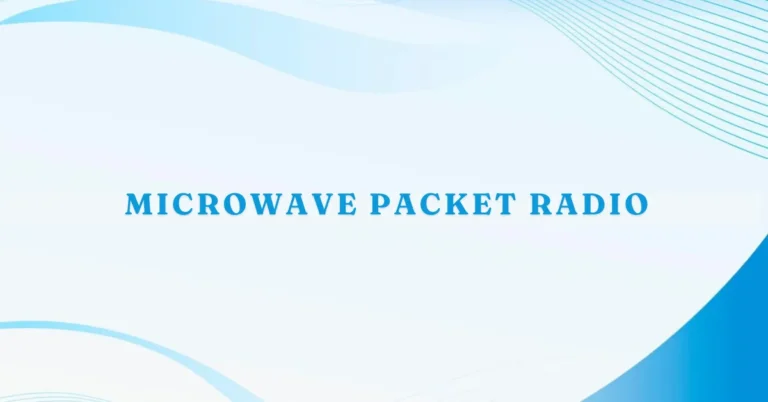Introduction to Microwave Packet Radio
In the fast-paced world of telecommunications, innovation drives connectivity. One technology that has made a significant impact is Microwave Packet Radio. This advanced communication method uses microwave frequencies to transmit data in packet form, revolutionizing how information flows across networks. As we explore this fascinating technology, we’ll delve into its evolution and Alcatel-Lucent’s pivotal role in shaping it. With advantages like speed and efficiency, Microwave Packet Radio opens doors to numerous applications while addressing both challenges and future possibilities in the ever-evolving tech landscape. Join us on this journey through the legacy of Microwave Packet Radio and discover why it remains a crucial component of modern communication systems.
The Evolution of Microwave Technology
Microwave technology has come a long way since its inception. Initially, it was primarily used for radar systems during World War II. Its high-frequency waves proved invaluable in locating enemy aircraft and ships.
As time progressed, microwave frequencies began to find their place in telecommunications. The 1970s ushered in advancements that allowed for the transmission of voice and data over longer distances with minimal loss.
With the advent of digital communication, microwave technology continued to evolve. It became essential for mobile networks and broadband services. This shift enabled faster data speeds and more reliable connections.
The introduction of packet radio further transformed the landscape. By breaking data into packets rather than continuous streams, efficiency skyrocketed while maintaining quality.
Today’s microwave solutions are not just about speed; they’re also about flexibility and scalability, catering to an increasingly connected world where demand is ever-growing.
Advantages of Using Microwave Packet Radio
Microwave Packet Radio offers several distinct advantages that make it a preferred choice in modern communications. One of its standout features is high transmission capacity. It allows for the efficient transfer of large amounts of data over long distances, making it ideal for urban and rural settings alike.
Flexibility is another key benefit. The technology easily adapts to various network configurations, ensuring seamless integration with existing infrastructure. This adaptability enhances both installation and maintenance processes.
Cost-effectiveness also plays a significant role in its appeal. Microwave Packet Radio often requires less investment compared to traditional wired systems, especially when laying down physical cables can be challenging or expensive.
Moreover, reliability shines through as weather-resistant microwave signals maintain performance even under adverse conditions. This resilience ensures uninterrupted connectivity vital for businesses and services that depend on constant communication channels.
Real-World Applications of Microwave Packet Radio
Microwave Packet Radio finds its way into numerous industries, showcasing its versatility and effectiveness. Telecommunications networks heavily rely on this technology to facilitate rapid data transmission across vast distances.
Its application in emergency services is noteworthy. During natural disasters, microwave packet radio systems can quickly establish communication links when traditional infrastructure fails.
Additionally, it plays a crucial role in the energy sector. Utility companies utilize this technology for real-time monitoring of power grids, ensuring stability and efficiency.
Transportation also benefits significantly from microwave packet radio. It supports intelligent traffic management systems that help reduce congestion and improve safety on major highways.
Moreover, remote areas gain better connectivity through the deployment of microwave packet radio solutions. This opens doors for education and healthcare services where conventional internet access may not be feasible.
Challenges and Future Possibilities for Microwave Packet Radio Technology
Microwave Packet Radios technology faces several challenges as it strives to keep pace with the rapidly evolving telecommunications landscape. One significant hurdle is the need for infrastructure upgrades. Many existing systems require modernization to support increased bandwidth and advanced features.
Interference from other wireless technologies can also pose a problem. As more devices connect, maintaining signal integrity becomes crucial. This demands sophisticated algorithms for managing frequency usage efficiently.
Despite these obstacles, the future of Microwave Packet Radios holds promise. Innovations in digital signal processing could enhance performance and reliability considerably.
Moreover, integrating artificial intelligence into network management might optimize resource allocation dynamically. The potential for seamless connectivity in remote areas remains an exciting frontier.
As industries seek faster data transmission without extensive cable networks, Microwave Packet Radio could emerge as a key player in bridging those gaps.
Conclusion
Microwave Packet Radio represents a significant advancement in telecommunications technology. As we’ve explored, it has evolved over the years, transitioning from traditional microwave transmission to sophisticated packet-based systems. Alcatel-Lucent played a pivotal role in this evolution, contributing innovative solutions that have shaped how data is transmitted wirelessly.
The benefits of Microwave Packet Radio are compelling. Its ability to deliver high-speed connectivity with minimal latency makes it ideal for various applications, from mobile network backhauls to disaster recovery setups. The real-world implications of this technology can be seen across industries—from telecommunications and broadcasting to smart cities and IoT deployments.
However, there are challenges on the horizon that need addressing. Issues such as spectrum availability and the integration with existing networks must be tackled for Microwave Packet Radios to reach its full potential. Yet, the future looks promising as advancements continue in both hardware and software domains.
Microwave Packet Radios stands at a crossroads of innovation and practicality—an exciting frontier that will likely play an essential role in shaping tomorrow’s communication landscape.
FAQs
Q: What is Microwave Packet Radios?
Ans: Microwave Packet Radios is a technology for high-capacity, packet-based data transfer over microwave frequencies.
Q: How did Alcatel-Lucent contribute to Microwave Packet Radios?
Ans: Alcatel-Lucent developed innovative solutions and patents, enhancing efficiency, reliability, and wireless backhaul performance.
Q: Why is Microwave Packet Radios important for networks?
Ans: It ensures seamless data connectivity for mobile operators, enterprises, and critical services, especially in IP-based networks.
Q: What challenges does Microwave Packet Radios address?
Ans: It tackles issues like data capacity, energy efficiency, and reliable communication in wireless backhaul systems.
Q: Is Microwave Packet Radio still used today?
Ans: Yes, it remains a cornerstone of modern telecommunications, with ongoing advancements under Nokia, Alcatel-Lucent’s successor.

